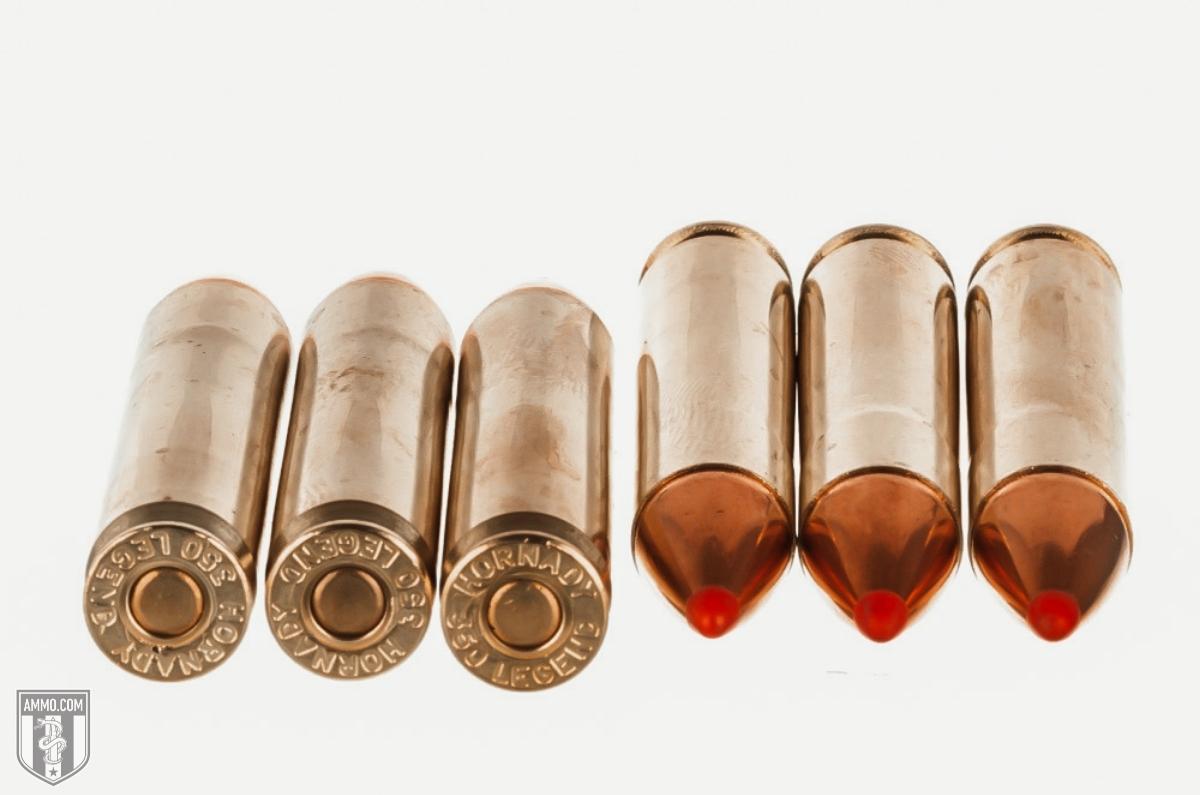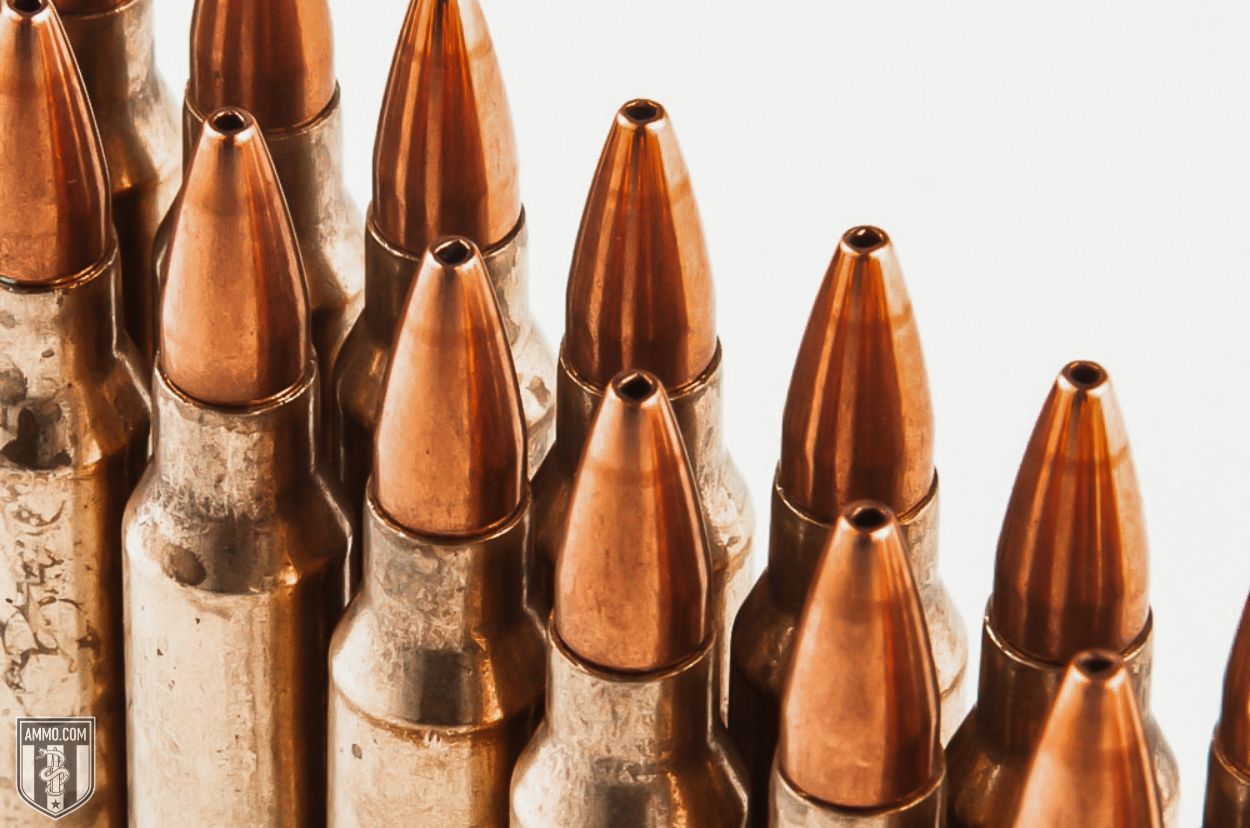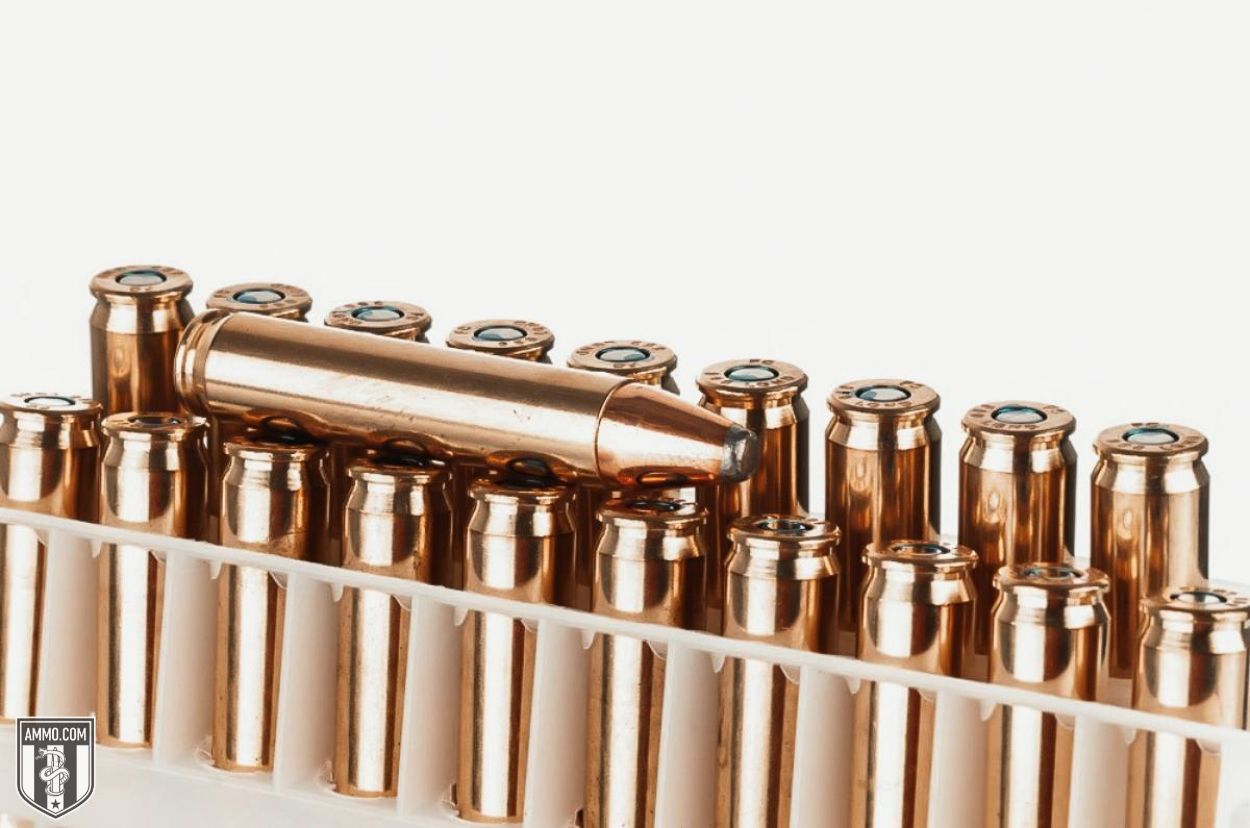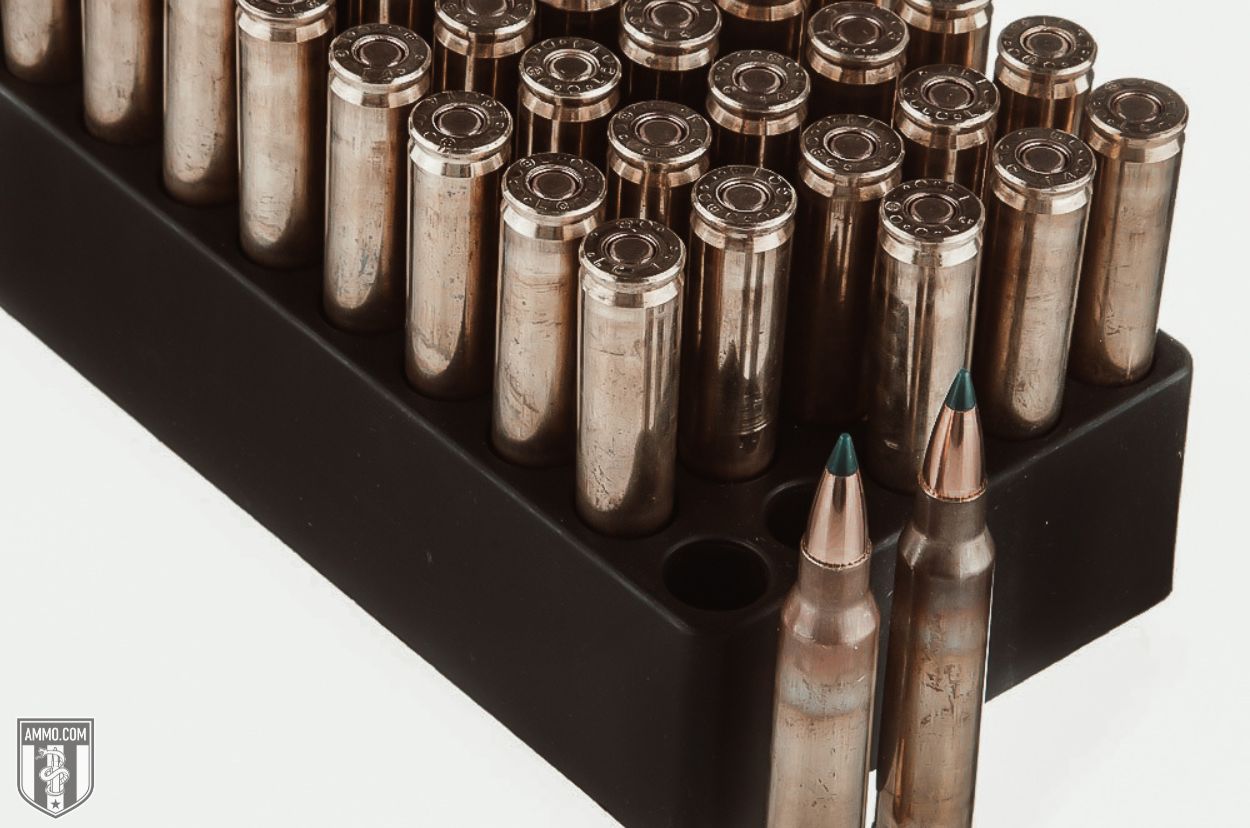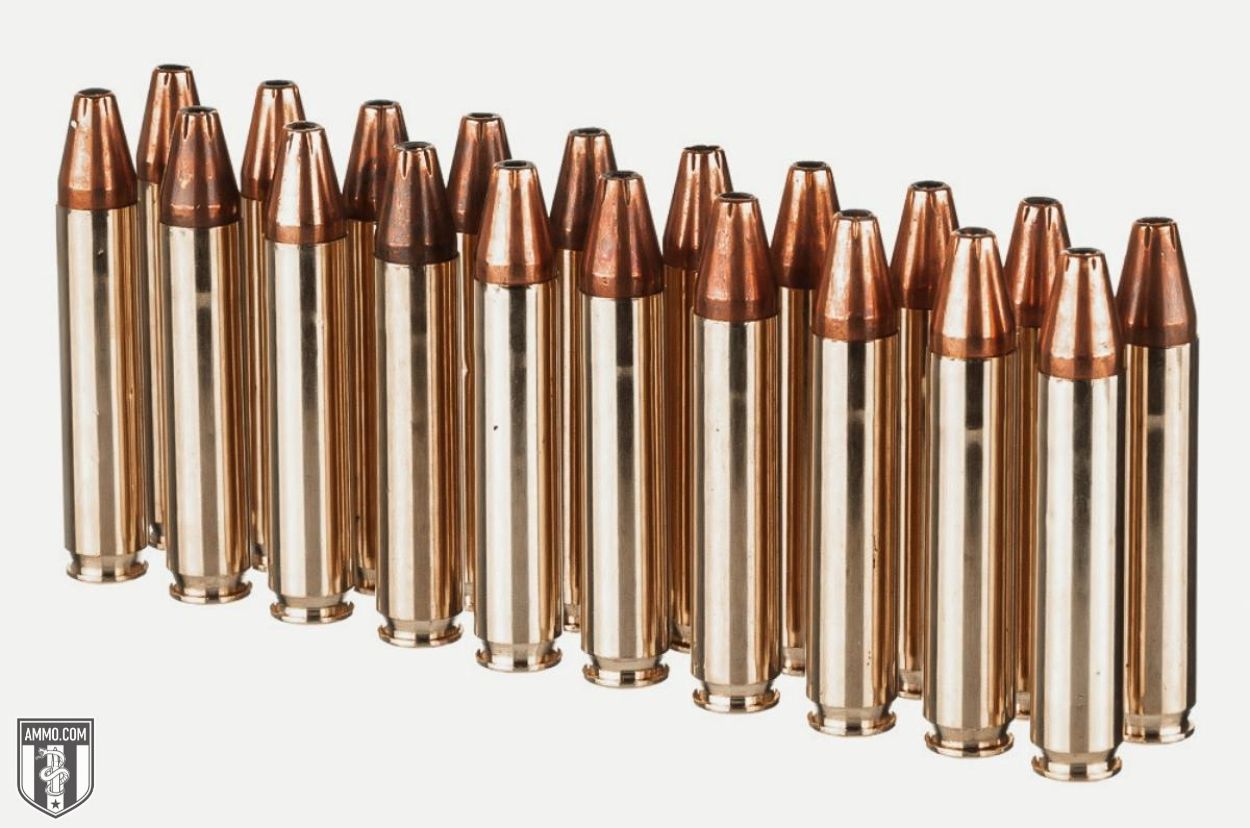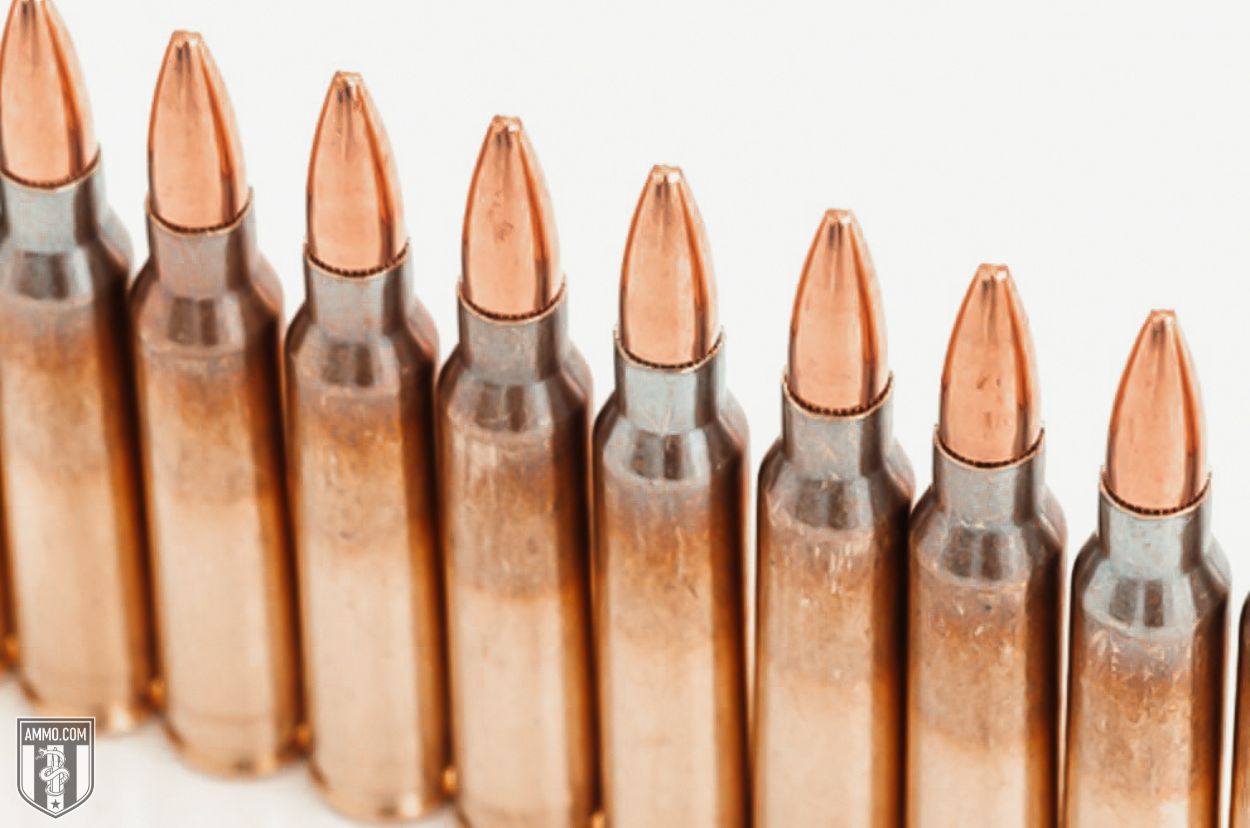350 Legend vs 5.56 NATO: Whitetail and Hogs Beware!
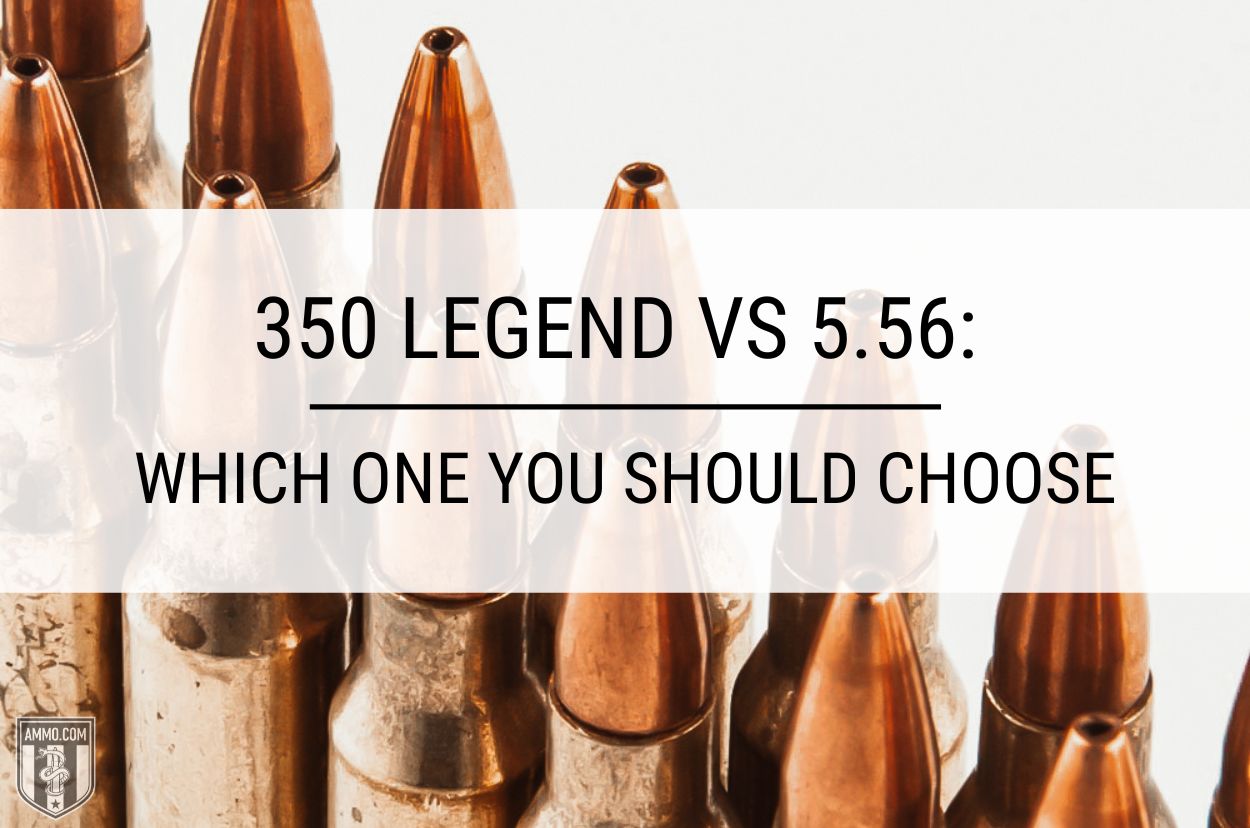
First Shots: 350 Legend vs 5.56 NATO
The 5.56x45mm NATO is an amazing cartridge and the unquestionable king of the AR-15 carbine. However, it leaves something to be desired when it comes to deer hunting as many shooters feel it is underpowered for this role.
Adapting new cartridges for the AR-15 platform for the purpose of putting Bambi in the freezer is nothing new. Rounds like the 300 Blackout, 6.8 SPC, 458 SOCOM, and 50 Beowulf are extremely popular and effective for bringing home the venison.
However, some Midwest states that previously only allowed muzzle loaders and shotguns for whitetail hunting have now permitted shooters to use straight-walled cartridges for deer season.
Seeing a need, Winchester Ammunition developed the 350 Legend to fulfill the straight-wall cartridge design requirements for deer hunting in these states. But how does it compare to the iconic 5.56 NATO and which one should you choose for your next hunting rifle?
In this article we will examine the similarities and differences between these two AR-15 cartridges and help you decide which is best for your next rifle purchase or home build.
What’s the Difference Between 350 Legend and 5.56 NATO?
The main difference between 350 Legend and 5.56x45 is that the 350 Legend is a straight-walled rifle cartridge while the 5.56 utilizes a bottleneck design. Furthermore, the 5.56 fires a lighter 0.224” bullet diameter while the 350 Legend fires heavier 0.355” diameter projectiles.
Cartridge Specs
When evaluating centerfire cartridges, it’s a good idea to analyze the cartridge specs to gain more knowledge of each.
The first major difference to discuss is the design on the cartridge case itself, as the 5.56x45 is a bottleneck case while the 350 Legend uses a straight-walled case. A bottleneck cartridge is typically more efficient, as it allows for a higher case capacity since the base of the bullet resides in the neck of the cartridge instead of the body.
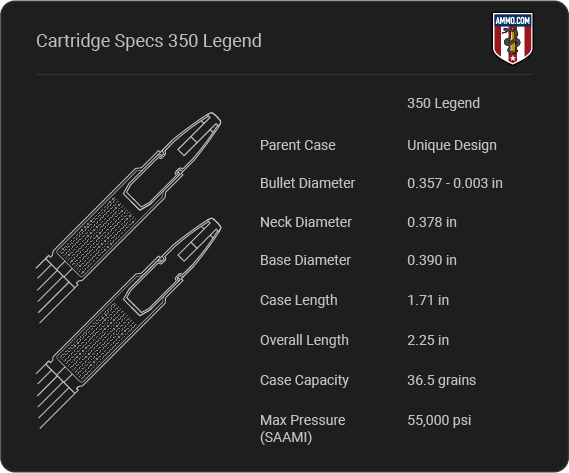
Winchester developed the 350 Legend in 2019 to meet big game straight-walled cartridge requirements for states like Ohio, Iowa, Michigan, Indiana, and Pennsylvania that require them for deer hunting. It is a unique design and has no parent case.
In contrast, the 5.56 NATO was developed in 1980 by FN Herstal using the 223 Remington (M193) as a parent cartridge. The 5.56 and 223 Rem have the same external case dimensions, but the new 5.56x45mm NATO round was designed to fire a heavier 62-grain bullet at higher pressure that required a faster 1:7 twist rate barrel for bullet stabilization.
The second most noticeable difference between these two cartridges is the bullet diameter each round fires. The 5.56 NATO fires the smaller 0.224” bullet diameter while the 350 Legend cartridge fires a larger 0.355” diameter bullet. For the 350 Legend, Winchester uses a bit of marketing magic in how it describes the projectiles its cartridge fires.
You’ll notice that the bullet diameter for 350 Legend is listed as 0.357”-0.003”, which is odd since caliber is usually just a single diameter measurement. This strange nomenclature is due to specific state requirements (Ohio in particular) that rifle cartridges used for deer hunting must fire a minimum of a 0.357” diameter bullet.
Winchester lists the 350 Legend as firing a 0.357” caliber bullet on their website, however all reloading data recommends the use of 0.355” bullets (otherwise known as 9mm). Although the 350 Legend “can” fire a 0.357” diameter bullet, it is typically loaded with the slightly thinner 0.355” bullet. That being said, the 350 Legend is listed as an acceptable deer hunting cartridge in Ohio at the time of writing.
As I’m sure you can guess, with a larger caliber comes a heavier bullet. The Legend cartridge typically fires bullets between 145 and 180 grains with the 150 and 160 grain bullets being the most popular. In contrast, the 5.56 is capable of firing bullets between 35-90 grains with the 55 and 62 gr bullet weights being the most common.
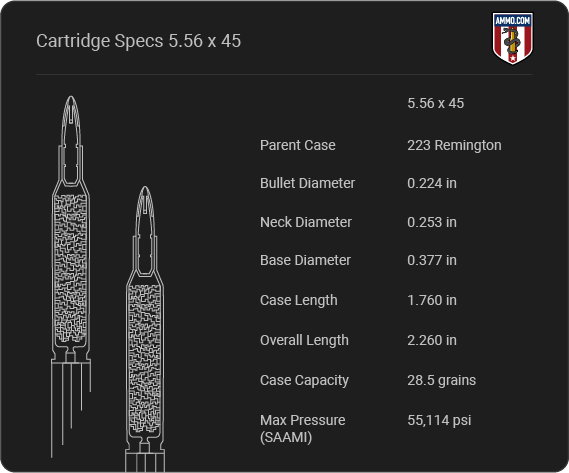
Although it is not listed, the 350 Legend and 5.56 have the same rim diameter (0.378”). This means that only a barrel change and new magazine are required to convert a 5.56 AR-15 to shoot the 350 Legend cartridge.
Both rifle cartridges have nearly the same case length, with the 5.56 being slightly longer at 1.76” compared to 1.71” for the Legend. The overall length for both cartridges is also nearly identical due to the restrictions of the AR-15 magazine. The 5.56 has an overall length of 2.26” compared to 2.25” for the 350 Legend.
Although both cases have similar external lengths, the 350 Legend has a higher case capacity than the 5.56. The 350 can hold 36.5 grains compared to 28.5 grains of case capacity for the 5.56. This higher case capacity is required for the 350 Legend to push the heavier projectiles it fires to acceptable muzzle velocities and muzzle energies.
The maximum pressure listed by SAAMI for both hunting cartridges is also nearly identical, with the 5.56 chamber capable of handling 55,114 psi compared to 55,000 psi for the Legend.
Recoil
Recoil is an important consideration when purchasing a new rifle as a round with heavy recoil will be more difficult to control and will slow your rate of follow up shots.
Recoil is affected primarily by muzzle velocity (FPS), powder charge, bullet weight, and rifle weight.
As the 350 Legend has a higher case capacity and fires a heavier bullet weight, it should come as no surprise that it has higher recoil than the 5.56. However, how much more recoil are we talking about?
As both rifle cartridges utilize the AR-15 platform, we will use this as the host rifle for a closer “apples-to-apples” comparison. On average, a standard AR-15 with a 20” barrel length will weigh around 6.5 pounds unloaded.
For the rounds in question, we’ve selected the Winchester .350 Legend Deer Season XP 150 gr Extreme Point traveling at 2,325 fps and a standard U.S. military 62 gr M855 round with a muzzle velocity of 3,110 fps.
Given these rounds, the 350 Legend will have a free recoil of around 10 ft-lbs compared to 4 foot-pounds for the 5.56 NATO. Clearly the 5.56 has less recoil than the 350 Legend, but it’s always important to keep things in context.
For example, the 30-30 Win has around 14 ft-lbs of free recoil while the 308 Win has around 21 foot-pounds. When comparing the 350 Legend to these classic deer hunting rounds, it’s easy to see how the 350 has low recoil.
Although the 5.56 NATO has less recoil than the 350 Legend, the is still an incredibly soft shooting round considering the capabilities it offers deer hunters.
Muzzle Velocity, Kinetic Energy, and Trajectory
The Winchester .350 Legend clearly has more recoil than the 5.56, but does all that recoil gain any ballistic performance?
In this section we will analyze four different rounds and observe their performance from zero to 500 yards.
For this example, we will analyze the military’s most common 5.56 ammo, the 55 gr FMJ M193 and 62 gr M855 FMJ. For the 350 Legend we’ve selected two popular hunting rounds, the Hornady Custom 165 gr FTX and the Winchester 180gr Power-Point. All rounds were assumed to have a 100 yard zero.
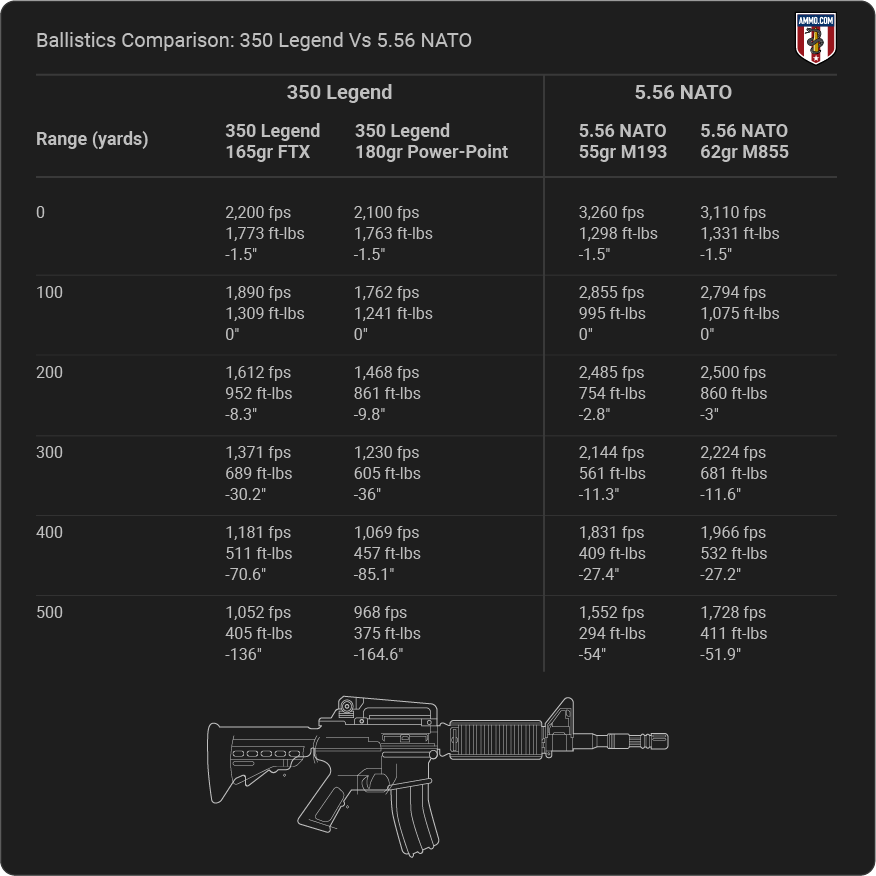
When it comes to muzzle velocity, the 5.56 is clearly the king of the hill by about 1,000 fps. Both 5.56 loads had muzzle velocities over 3,000 fps while the 350 Legend loads topped out at 2,200 fps for the 165 gr FTX and 2,100 fps for the 180 gr Power-Point.
This high muzzle velocity also means that the 5.56 will have a flatter trajectory (making it better for long-range shots) compared to the 350 Legend cartridge. At 500 yards, M193 round has experienced -54” of bullet drop while the M855 dropped nearly -52”. In contrast, both 350 Legend rounds have dropped over 130” at 500 yards, with the 165 gr FTX at -136” and the 180 Power-Point at -164”.
This massive difference in trajectory is due to the 5.56 remaining above supersonic speeds out to around 700 yards while the 350 Legend cartridge dips below the speed of sound around 400 yards. When this happens, gravity will affect a bullet’s flight path more drastically.
Although the 350 Legend might not be a speed demon like the 5.56, it makes up for this is kinetic energy as it boasts nearly 33% more muzzle energy than the 5.56. Both NATO rounds have on average 1,300 foot-pounds of muzzle energy while the 350 Legend rounds average around 1,760 ft-lbs of kinetic energy.
So, what conclusions can we draw from this data?
The 5.56 NATO is a rifleman’s cartridge at its core. It was designed for long-range shots with its blistering muzzle velocity and flat trajectory. In contrast, the 350 Legend has more stopping power than the 5.56, packing in enough foot-pounds of energy to drop a deer at 200 yards.
Ballistic Coefficient and Sectional Density
Ballistic coefficient (BC) is a measure of how aerodynamic a bullet is and how well it will resist wind deflection. Sectional density (SD) is a way to evaluate the penetration ability of a bullet based on its external dimensions, design, and weight.
Typically, longer and heavier bullets will have a higher BC as they can resist wind drift more efficiently.
In general, 55 gr FMJ 5.56 ammo has a BC around 0.24 while 62 gr FMJ’s typically have a BC around 0.3. In contrast, the 165 gr FTX 350 Legend bullet analyzed in the previous section has a BC of 0.25 while the 180 gr Power-Point measured in at 0.221.
Although the 350 Legend fires heavier bullet weights, they are wider and not very aerodynamic. On the other hand, the 5.56 can fire Spitzer-style bullets, which are considerably more aerodynamic in comparison.
In terms of sectional density, the 350 Legend is slightly superior to the 5.56 thanks to its increased kinetic energy. In general, 350 Legend ammo has an SD of around 0.19-0.2 while 5.56 ammo has an SD between 0.15 and 0.18.
Hunting
Both the 5.56 and 350 Legend cartridge have areas where they shine in terms of hunting capabilities, so understanding which is best for any given hunting situation is key to success.
When it comes to varmint hunting, the 5.56 is clearly the better option. It has less recoil, a flatter trajectory, and light bullet weights to preserve the hide and meat (if you’re into that). The 350 Legend can be used for varmint hunting, but its arching trajectory and heavy bullets are not ideal for this purpose.
For medium sized game animals like coyotes, I’ll still give the 5.56 the nod for its longer effective range and flatter trajectory.
However, for big game animals like whitetail deer and hogs, the 350 Legend is clearly the better option thanks to its higher muzzle energy. The 5.56 is capable of taking down a deer, especially with bullets heavier than 65 grains like the Federal Fusion, however most states prohibit the use of 5.56/223 Rem for deer hunting.
The 350 Legend offers deer hunters the semi-automatic capability of the AR-15 platform and around a 200 yard effective range, which is about the same as the 300 Blackout with 1/3 the recoil of the 450 Bushmaster.
Ammo and Rifle Cost/Availability
Ammo and rifles for the 5.56 are relatively inexpensive and easy to come by.
As one of the most popular centerfire rifle cartridges in North America, the 5.56 NATO is by far the least expensive round of the two. Virtual every ammo manufacturer, like Winchester, Remington, Hornady, Federal, and PMC, has at least one offering 5.56 ammo. This popularity helps keep costs down which makes the 5.56 a great plinking round.
Factory ammo for 556 is easy to find at almost any place that sells firearms or ammo, whereas 350 Legend ammo will be much for difficult to source at your local stores. Inexpensive FMJ 556 plinking ammo can be had for around $0.45/round while premium hunting ammo will typically cost around $1-2/round. You can also purchase 556 bulk ammo to increase your overall cost savings per round.
Although the 350 Legend is still a relatively new cartridge, there are several ammo manufacturers that currently offer hunting ammo for it. Winchester Ammunition is by far the largest supplier, however Barnes, Hornady, Federal, and Browning also have offerings for the Legend.
If you like to shoot with a suppressor, Hornady and Winchester both offer subsonic ammo for the 350 Legend, which would make for an incredibly shot shooting and quite self-defense carbine. Think about having a semi-auto rifle with more kinetic energy than a 44 Magnum handgun that won’t break your eardrums when shot indoors!
At the time of writing, inexpensive practice 350 Legend ammo can be had for around $0.80/round while premium hunting ammo ranges anywhere between $1.50 and $3/round.
In terms of rifle availability and price, the 5.56 NATO cannot be beat as the AR-15 is the most popular rifle in America. The vast majority of AR-15’s produced are chambered in 5.56, so your rifle options are extensive.
When looking for a bolt-action 5.56 rifle, you’ll quickly discover that most of them are chambered in 223 Rem and not 5.56. As the 223 Remington is marketed primarily as a varmint round, it holds a very large market share in the bolt-action rifle space.
Remember that it is NOT safe to fire 5.56 ammo in a 223 rifle as we discuss in this article HERE: 5.56 vs 223
If you really want a bolt action rifle in 5.56, there are a few options available like the Ruger American Ranch, the Ruger GUNSITE Scout, and Mossberg MVP Patrol. Neither cartridge is well suited for use in a lever action rifle.
Factory produced 350 Legend AR-15 rifles are predominantly available from Ruger, Patriot Ordinance, CMMG, Bear Creek Arsenal, and Wilson Combat. In terms of bolt-action rifles for the 350 Legend, you can pick from brands like Winchester, Savage, Ruger American, Howa, Weatherby, and CVA. If for some reason you want a single-shot rifle (or live in Illinois), you can find one from Henry or Traditions Outfitters.
However, if you want the best of both worlds, any 5.56 AR-15 can easily be converted to 350 Legend by swapping the upper receiver. This means you can have one AR15 lower receiver and two different uppers, allowing you to shoot two different calibers from the same rifle.
Reloading
If you like to handload your own ammo, both cartridges offer you a lot of options for customization in terms of projectiles and powders to make the perfect reloads for your AR-15 rifle.
The 5.56 will be the easier cartridge to handload for, as once fired brass, inexpensive FMJ bullets, and powders are easy to find. Bullets for the 5.56 are plentiful can also be used for other 0.224” caliber cartridges such as the 22-250 Remington, 220 Swift, and 224 Valkyrie.
It should also be noted that there are no resizing dies made for 5.56 NATO and only 223 Remington reloading dies are available. As the 5.56 and 223 Rem have the same external case dimensions, a 223 die will do just fine resizing your 5.56 brass.
Although reloading components will be widely more accessible for the 5.56, there are still plenty of options available for the 350 Legend. Reloading dies are readily available from quality manufacturers like Redding, Lee Precision, RCBS, and Hornady.
Brass, on the other hand, will be more difficult to source as the 350 Legend is a relatively new case. At the time of writing, there are three primary manufacturers of 350 Legend brass: Winchester, Starline, and Hornady.
Bullets for your 350 Legend reloads will be easy to find, just make sure you’re using 0.355” projectiles and you should be good to go. Hornady, Barnes, Winchester, and Lehigh Defense all have bullets that are suitable for the 350 Legend.
5.56 NATO Ballistic Chart
Our experts here at Ammo.com have assembled ballistic data for the 5.56 NATO for various factory ammo options. All that’s required is to make your bullet selection and your data is below!
Note: This information comes from the manufacturer and is for informational purposes only. The actual ballistics obtained with your firearm can vary considerably from the advertised ballistics. Also, ballistics can vary from lot to lot with the same brand and type load.
| 5.56x45mm Bullet WEIGHT | Muzzle VELOCITY (fps) | Muzzle ENERGY (ft. lbs.) | TRAJECTORY (in.) | |||||||||||
|---|---|---|---|---|---|---|---|---|---|---|---|---|---|---|
| Muzzle | 100 yds. | 200 yds. | 300 yds. | 400 yds. | Muzzle | 100 yds. | 200 yds. | 300 yds. | 400 yds. | 100 yds. | 200 yds. | 300 yds. | 400 yds. | |
| 55 Grain NATO | 3130 | 2740 | 2382 | 2051 | 1750 | 1196 | 917 | 693 | 514 | 372 | 1.1 | 0 | -7.3 | -23 |
| 75 Grain NATO | 2910 | 2676 | 2543 | 2242 | 2041 | 1410 | 1192 | 1002 | 837 | 693 | 1.2 | 0 | -7 | -21 |
Parting Shots: 5.56 vs 350 Legend
The 350 Legend and 5.56 NATO are two AR-15 cartridges that excel in their intended roles.
If you’re looking for a long-range target shooting round or something that’s inexpensive to go plinking with over the weekend, then go with the 5.56.
As cool as the 350 Legend is, it fills a niche role in the deer hunting community that most hunters don’t need to contend with. So, if you don’t live in the Midwest or don’t need to hunt with a straight-wall cartridge, then it’s unlikely you’ll be too interested in the 350 Legend.
That being said, if you don’t plan on taking shots on whitetail or hogs outside of 200 yards, the 350 Legend makes an excellent choice for hunting with an AR-15, bolt-action rifle, and even a single-shot.
Regardless of which one you choose, make sure you get all your ammo here at Ammo.com and I’ll see you out on the range!
Ammo Comparisons
- .308 vs 5.56
- 6.5 Creedmoor vs .308
- .300 Blackout vs .308
- .300 Win Mag vs .308
- .243 vs .308
- .308 vs .30-06
- 7mm-08 vs .308
- .270 vs .308
- 7.62x39 vs .308
- .223 vs .308
- .338 Lapua vs .308
- .380 ACP vs 9mm
- .223 vs 5.56
- .300 Blackout vs 5.56
- 9mm vs 45 ACP
- 9mm vs 40 S&W
- .357 SIG vs 9mm
- 10mm vs 9mm
- 9mm vs 9mm Luger
- .243 vs .270
- .300 Win Mag vs .30-06
- .270 vs .30-06
- .40 vs .45
- 38 Special vs 357
- 9mm vs 40 vs 45
- 5.56 vs 7.62x39
- 338 Lapua vs .30-06
- .30-30 vs .30-06
- 300 PRC vs 338 Lapua
- .30-06 vs 7mm
- 300 Win Mag vs 338 Lapua
- 300 PRC vs 300 Win Mag
- 300 WSM vs 300 Win Mag
- 338 Win Mag vs 338 Lapua
- 12 Gauge vs 20 Gauge
- 10mm vs 357 Mag
- .30-30 vs 7.62x39
- 224 Valkyrie vs 22-250
- 17 HMR vs 22 Mag
- 7.62x39 vs .300 Blackout
- 45 ACP vs 45 Auto
- 45-70 vs 30-30
- 300 Blackout vs 223
- 357 Magnum vs 9mm
- 350 Legend vs 300 Blackout
- 224 Valkyrie vs 223
- 45 ACP vs 38 Super
- 6.5 Grendel vs .308
- 17 HMR vs 22 LR
- 10 Gauge vs 12 Gauge
- 22-250 vs 223
- 45 Colt vs 45 ACP
- 350 Legend vs 30-30
- 5.7x28 vs 223
- 5.7 vs 9mm
- 5.56 vs 5.7
- 22 vs 9mm
- Buckshot vs Birdshot
- 450 Bushmaster vs 308
- 450 Bushmaster vs 223
- Buckshot vs Slug
- 6.5 Grendel vs 5.56 vs 223
- 6mm ARC vs 6.5 Grendel
- 44 vs 45
- 458 SOCOM vs 5.56
- 357 vs 44
- 32 ACP vs 380
- 300 Win Mag vs 338 Win Mag vs 338 Lapua Mag
- 450 Bushmaster vs 458 SOCOM vs 50 Beowulf
- 6mm Creedmoor vs 6.5 Creedmoor
- TMJ vs FMJ
- 44 Special Vs 44 Magnum
- 45 90 vs 45 70
- 6.8 Western vs 6.8 SPC
- 50 Beowulf vs 50 BMG
- 26 Nosler vs 6.5 PRC
- 28 Gauge vs 410
- 6.8 SPC vs 5.56
- 6.8 SPC vs 6.5 Grendel
- 6.8 Western vs 7mm Rem Mag vs .28 Nosler
- 6.8 Western vs 6.5 Creedmoor
- 22 Hornet vs 223
- 6.8 Western vs 6.5 PRC
- .410 vs 12 Gauge
- .410 vs 20 Gauge
- 22 LR vs 22 Mag
- 6mm ARC vs 243
- 7mm-08 vs 270
- 243 vs 6.5 Creedmoor
- Nickel vs Brass Casing
- 204 Ruger vs 223
- 50 Beowulf vs 5.56
- 260 Remington vs 6.5 Creedmoor
- 6mm Remington vs 243
- 28 Nosler vs 300 PRC
- 50 Beowulf vs 50 AE
- 22 Nosler vs 22-250
- 450 Marlin vs 45-70
- 300 Win Mag vs 300 Norma
- 458 SOCOM vs 300 Blackout
- 38-55 vs 45-70
- 22 Hornet vs 22 LR
- 300 Norma vs 338 Lapua
- 338 Lapua vs 50 BMG
- 28 Nosler vs 300 Win Mag
- 28 Nosler vs 6.5 Creedmoor
- 204 vs 22-250
- 458 SOCOM vs 45 70
- 44 40 vs 45 70
- 6.8 SPC vs 6.5 Creedmoor
- 450 Bushmaster vs 30-06
- 7mm Rem Mag vs 300 Win Mag
- 30 Carbine vs 223
- 25-06 vs 30-06
- 26 Nosler vs 28 Nosler
- 16ga vs 12ga
- 30 06 vs 7.62 x54R
- 9mm Makarov vs 9mm Luger
- 350 Legend vs 223
- 30 Carbine vs 5.56
- 6.5x55 vs 6.5 Creedmoor
- 6.5 Creedmoor vs 270 vs 25-06
- M193 vs M855
- 450 Bushmaster vs 458 SOCOM
- 6.5 Grendel vs 6.5 Creedmoor
- 350 Legend vs 5.56
- .277 Fury vs 6.8 SPC
- 277 Fury vs 300 Win Mag
- 10mm vs .45 ACP
- 277 Fury vs 223
- 6.8 SPC vs 300 Blackout
- 6.5 PRC vs 6.5 Creedmoor
- 277 Fury vs 308
- 277 Fury vs 6.5 Creedmoor
- 350 Legend vs 450 Bushmaster
- 277 Fury Vs 5.56 NATO
- 10mm vs 40S&W
- 32 ACP vs 9mm
- 32 Special vs 9mm
- 8.6 Blackout vs 300 Blackout
- 30 Super Carry vs. 9mm
- 5.56 vs 9mm
- .50 Action Express vs 9mm
- 7.62x25 vs. 9mm
- 10mm vs 44 Magnum
- 300 Blackout vs 300 Win Mag
- 6.5 Grendel vs 300 Blackout
- 460 Rowland vs 10mm
- 300 RUM vs 300 PRC
- 300 Norma vs 300 PRC
- 45 GAP vs 45 ACP
- 7mm PRC vs 300 Win Mag
- 300 PRC vs 6.5 Creedmoor
- 300 PRC vs 308
- 357 SIG vs 357 Mag
- 7.62x39 vs 7.62x51
